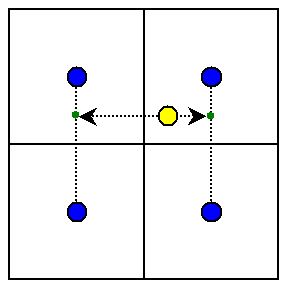
The simple example of liner interpolation. In this case, the value at yellow point is 6.8 y/(x+y) + 2.4 x/(x+y)
This online system generates meteorological data for inputting the SEIB-DGVM v3.00 and later. This generator is based on CRU-JRA2.4. Another generator based on CRU-NCEP-SRB is available here.
Citation of this climate data can be foun on the following page.
CRU JRA v2.4: A forcings dataset of gridded land surface blend of Climatic Research Unit (CRU) and Japanese reanalysis (JRA) data; Jan.1901 - Dec.2022.
7 Feb 2025
Under conditions where the air temperature is low and the saturated vapor pressure becomes extremely small, the output value of relative humidity was unstable, frequently switching between 0% and 100%. Therefore, I modified the system to always output 100% when the air temperature falls below -25℃.
23 Nov 2023
The data converter of CRU-JRA2.4 for inputting the SEIB-DGVM ver3.0 and later is now open to the public.
1. This web-system can be used by any person and by any organs for fair usages.
2. The data is provided with no guarantees as to the accuracy, correctness or utility of the output produced.
3. Publications should give adequately citation to the original climate dataset (see section "About original climate dataset").
(0) 1 year daily climatic data (air temperature, soil temperature, precipitation, total cloud cover, specific humidity, wind velocity, and downward short wave radiation) during 1950 was obtained from the NCEP/NCAR reanalysis daily climatic dataset. Spatial resolution of the original data was 192×94 global grids, and was linearly interpolated to 0.5 degree grid mesh, which corresponds to the spatial resolution in CRU TS3.22 data. Using this interpolated daily data, all items (except for daily range of air temperature) of CRU TS3.22 monthly climatic data will be scaled to daily as follows.
For air temperature, NCEP/NCAR reanalysis will be linearly scaled by adding a constant (month and location specific) so that its monthly mean becomes as same as the values of corresponding month and location of CRU-TS3.22.
For cloudness, NCEP/NCAR reanalysis will be linearly scaled by multiplying a constant (month and location specific) so that its monthly mean becomes as same as the values of corresponding month and location of CRU-TS3.22.
For precipitation and specific humidity, daily values of NCEP/NCAR reanalysis will be linearly scaled by multiplying a constant (month and location specific) so that its monthly total becomes as same as the values of corresponding month of CRU-TS3.22.
For soil temperatures and wind velocity, NCEP/NCAR reanalysis was simply employed.
(1) From specified latitude and longitude, select 4 grids that will be referred to generate data (see "Data interpolation method").
(2) Generate data through linear interpolation, which is described below. This interpolation procedure is omitted for ocean grids, which do not contain any values.
(3) Display generated data in the format that meets to input to SEIB-DGVM.
From coarse original data, this web system generate climate data of your specified location through simple liner interpolation as below.

The simple example of liner interpolation.
In this case, the value at yellow point is 6.8 y/(x+y) + 2.4 x/(x+y)

To obtain the interpolated value at your selected location, values at most proximate 4 grids will be referred. First, values at green dots will be obtained by above method. Then, applying the same method to the green dots, value at yellow dot will be calculated.
(Sorry in Japanese)
このシステムで使用している全球気象データ(0.5度、Daily、122年)を提供します。無料です。上のConditions of useをお守り頂き、そして論文のacknowledgmentにでも私の名前を書いて下さるのが提供条件です。データセットの大体の大きさは、tarzip圧縮したもので約78GBです。データの諸元をまとめたテキストファイルと、データ変換に使用したFortran90のコードも添付します。
ご希望の方は、事前にコンタクトを取った後、ポータブルSSD等を郵送して下さい。データをコピーしてから、着払い便(応相談)にて返送いたします。